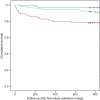Risk of death following admission to a UK hospital with diabetic ketoacidosis
- PMID: 27397023
- PMCID: PMC5016550
- DOI: 10.1007/s00125-016-4034-0
Risk of death following admission to a UK hospital with diabetic ketoacidosis
Abstract
Aims/hypothesis: The aim of this study was to assess the risk of death during hospital admission for diabetic ketoacidosis (DKA) and, subsequently, following discharge. In addition, we aimed to characterise the risk factors for multiple presentations with DKA.
Methods: We conducted a retrospective cohort study of all DKA admissions between 2007 and 2012 at a university teaching hospital. All patients with type 1 diabetes who were admitted with DKA (628 admissions of 298 individuals) were identified by discharge coding. Clinical, biochemical and mortality data were obtained from electronic patient records and national databases. Follow-up continued until the end of 2014.
Results: Compared with patients with a single DKA admission, those with recurrent DKA (more than five episodes) were diagnosed with diabetes at an earlier age (median 14 [interquartile range 9-23] vs 24 [16-34] years, p < 0.001), had higher levels of social deprivation (p = 0.005) and higher HbA1c values (103 [89-108] vs 79 [66-96] mmol/mol; 11.6% [10.3-12.0%] vs 9.4% [8.2-10.9%], p < 0.001), and tended to be younger (25 [22-36] vs 31 [23-42] years, p = 0.079). Antidepressant use was greater in those with recurrent DKA compared with those with a single episode (47.5% vs 12.6%, p = 0.001). The inpatient DKA mortality rate was no greater than 0.16%. A single episode of DKA was associated with a 5.2% risk of death (4.1 [2.8-6.0] years of follow-up) compared with 23.4% in those with recurrent DKA admissions (2.4 [2.0-3.8] years of follow-up) (HR 6.18, p = 0.001).
Conclusions/interpretation: Recurrent DKA is associated with substantial mortality, particularly among young, socially disadvantaged adults with very high HbA1c levels.
Keywords: Deprivation; Diabetes; Diabetic ketoacidosis; HbA1c; Mortality; Type 1 diabetes.
Conflict of interest statement
Funding This research received no specific grant from any funding agency in the public, commercial or not-for-profit sectors. Duality of interest statement The authors declare that there is no duality of interest associated with this manuscript. Contribution statement FWG and KAL conceived this study with subsequent input from WLT and JG in developing study design and contributing to data collection and analysis. FWG wrote the initial draft of the manuscript with revisions provided from all authors. The final manuscript was approved by all authors. FWG is the guarantor of this work.
Figures
Comment in
-
Diabetes: Recurrent DKA - for whom the bell tolls.Nat Rev Endocrinol. 2016 Oct;12(10):562-4. doi: 10.1038/nrendo.2016.137. Epub 2016 Aug 26. Nat Rev Endocrinol. 2016. PMID: 27564715 No abstract available.
References
-
- Wright J, Ruck K, Rabbitts R, et al. Diabetic ketoacidosis (DKA) in Birmingham, UK, 2000–2009: an evaluation of risk factors for recurrence and mortality. Br J Diabetes Vasc Dis. 2009;9:278–282. doi: 10.1177/1474651409353248. - DOI
MeSH terms
Substances
LinkOut - more resources
Full Text Sources
Other Literature Sources


